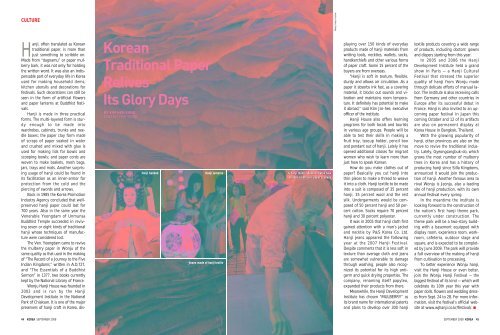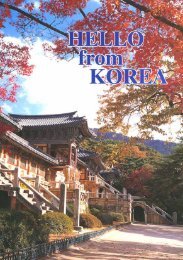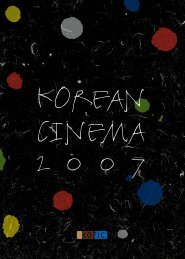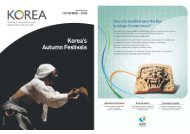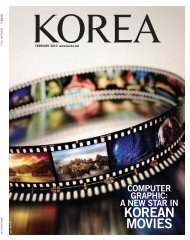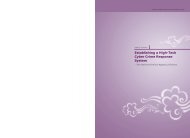Download - Korea.net
Download - Korea.net
Download - Korea.net
- No tags were found...
Create successful ePaper yourself
Turn your PDF publications into a flip-book with our unique Google optimized e-Paper software.
CULTURE<br />
Wonju Hanji Festival<br />
Hanji, often translated as <strong>Korea</strong>n<br />
traditional paper, is more than<br />
just something to scribble on.<br />
Made from “dagnamu” or paper mulberry<br />
bark, it was not only for holding<br />
the written word. It was also an indispensable<br />
part of everyday life in <strong>Korea</strong><br />
used for making household items,<br />
kitchen utensils and decorations for<br />
festivals. Such decorations can still be<br />
seen in the form of artificial flowers<br />
and paper lanterns at Buddhist festivals.<br />
Hanji is made in three practical<br />
forms. The multi-layered form is sturdy<br />
enough to be made into<br />
wardrobes, cabi<strong>net</strong>s, trunks and needle<br />
boxes; the paper clay form made<br />
of scraps of paper soaked in water<br />
and crushed and mixed with glue is<br />
used for making lids for bowls and<br />
scooping bowls; and paper cords are<br />
woven to make baskets, mesh bags,<br />
jars, trays and mats. Another surprising<br />
usage of hanji could be found in<br />
its facilitation as an inner-armor for<br />
protection from the cold and the<br />
piercing of swords and arrows.<br />
Back in 1985 the <strong>Korea</strong> Promotion<br />
Industry Agency concluded that wellpreserved<br />
hanji paper could last for<br />
700 years. Also in the same year the<br />
Venerable Yeongdam of Unmunsa<br />
Buddhist Temple succeeded in reviving<br />
seven or eight kinds of traditional<br />
hanji whose techniques of manufacture<br />
were considered lost.<br />
The Ven. Yeongdam came to revive<br />
the mulberry paper in Wonju of the<br />
same quality as that used in the making<br />
of “The Record of a Journey to the Five<br />
Indian Kingdoms,” written in A.D.727,<br />
and “The Essentials of a Buddhist<br />
Sermon” in 1377, two books currently<br />
kept by the National Library of France.<br />
Wonju Hanji House was founded in<br />
2002 and is run by the Hanji<br />
Development Institute in the National<br />
Park of Chiaksan. It is one of the major<br />
preservers of hanji craft in <strong>Korea</strong>, dis-<br />
<strong>Korea</strong>n<br />
Traditional Paper<br />
Relives<br />
Its Glory Days<br />
BY KIM HEE-SUNG<br />
KOREA.NET STAFF WRITER<br />
Hanji hanbok Hanji lanterns A hanji master demonstrates how<br />
<strong>Korea</strong>n traditional paper is made<br />
Jeans made of hanji textile<br />
playing over 150 kinds of everyday<br />
products made of hanji materials from<br />
writing tools, neckties, wallets, socks,<br />
handkerchiefs and other various forms<br />
of paper craft. Some 15 percent of the<br />
buyers are from overseas.<br />
“Hanji is soft in texture, flexible,<br />
sturdy and allows air circulation. As a<br />
paper it absorbs ink fast, as a covering<br />
material, it blocks out sounds and vibration<br />
and maintains room temperature.<br />
It definitely has potential to make<br />
it abroad,” said Kim Jin-hee, executive<br />
officer of the institute.<br />
Hanji House also offers learning<br />
programs for both locals and tourists<br />
in various age groups. People will be<br />
able to test their skills in making a<br />
fruit tray, teacup holder, pencil box<br />
and pendant out of hanji. Lately it has<br />
opened additional classes for migrant<br />
women who wish to learn more than<br />
just how to speak <strong>Korea</strong>n.<br />
How do you make clothes out of<br />
paper? Basically you cut hanji into<br />
thin pieces to make a thread to weave<br />
it into a cloth. Hanji textile to be made<br />
into a suit is composed of 35 percent<br />
hanji, 35 percent wool and the rest<br />
silk. Undergarments would be composed<br />
of 50 percent hanji and 50 percent<br />
cotton. Socks require 70 percent<br />
hanji and 30 percent polyester.<br />
It was in 2005 that hanji cloth first<br />
gained attention with a man’s jacket<br />
and necktie by P&S <strong>Korea</strong> Co. Ltd.<br />
Hanji jeans appeared the following<br />
year at the 2007 Hanji Festival.<br />
Despite comments that it is less soft in<br />
texture than average cloth and jeans<br />
are somewhat vulnerable to damage<br />
through washing, people also recognized<br />
its potential for its high antigerm<br />
and quick drying properties. The<br />
company, renaming itself papytex,<br />
expanded their products from there.<br />
Meanwhile, the Hanji Development<br />
Institute has chosen “MULBERRY” as<br />
its brand name for international patents<br />
and plans to develop over 300 hanji<br />
textile products covering a wide range<br />
of products, including doctors’ gowns<br />
and diapers starting from this year.<br />
In 2005 and 2006 the Hanji<br />
Development Institute held a grand<br />
show in Paris — a Hanji Cultural<br />
Festival that stressed the superior<br />
quality of hanji from Wonju made<br />
through delicate efforts of manual labor.<br />
The institute is also receiving calls<br />
from Germany and other countries in<br />
Europe after its successful debut in<br />
France. Hanji is also invited to an upcoming<br />
paper festival in Japan this<br />
coming October and 12 of its artifacts<br />
are also on permanent display at<br />
<strong>Korea</strong> House in Bangkok, Thailand.<br />
With the growing popularity of<br />
hanji, other provinces are also on the<br />
move to revive the traditional industry.<br />
Lately, Gyeongsangbuk-do, which<br />
grows the most number of mulberry<br />
trees in <strong>Korea</strong> and has a history of<br />
producing hanji since Silla Kingdoms,<br />
announced it would join the production<br />
of hanji. Another famous area to<br />
rival Wonju is Jeonju, also a leading<br />
site of hanji production, with its own<br />
annual festival every spring.<br />
In the meantime the institute is<br />
looking forward to the construction of<br />
the nation’s first hanji theme park,<br />
currently under construction. The<br />
theme park will be a two-story building<br />
with a basement equipped with<br />
display room, experience room, workroom,<br />
cafeteria, outdoor stage and<br />
square, and is expected to be completed<br />
by June 2009. The park will provide<br />
a full overview of the making of hanji<br />
from cultivation to processing.<br />
To better experience Wonju hanji,<br />
visit the Hanji House or even better,<br />
join the Wonju Hanji Festival — the<br />
biggest festival of its kind — which will<br />
celebrate its 10th year this year with<br />
paper dolls, flowers and wedding dresses<br />
from Sept. 24 to 28. For more information,<br />
visit the festival’s official website<br />
at www.wjhanji.co.kr/festival/. ■<br />
44 KOREA SEPTEMBER 2008<br />
SEPTEMBER 2008 KOREA 45


